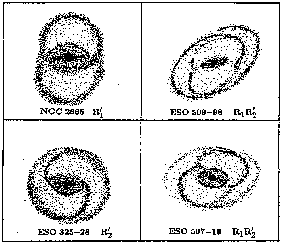
|



4. RECENT REVISIONS TO THE CLASSIFICATION OF RINGED GALAXIES
4.1. Outer Ring and Pseudoring Morphologies

|
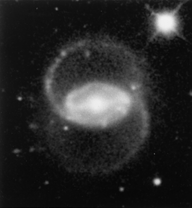
| 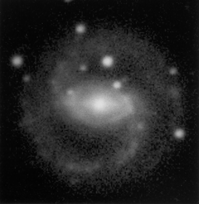
|
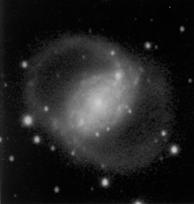
| 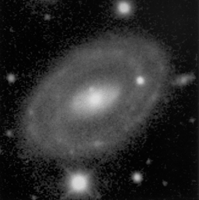
|
The classification of ringed galaxies has had one major revision since the works of de Vaucouleurs (1959a) and Sandage (1961). The morphology of outer rings and pseudorings in barred galaxies includes subcategories that strongly resemble the gaseous rings and pseudorings that developed near the outer Lindblad resonance (OLR) in the test-particle simulations of Schwarz (1981; see Buta and Crocker 1991). These simulations are discussed in section 12.2, but we illustrate the observed categories in this section to define the morphological symbols that we will use for what will be referred to as the ``OLR subclasses.''
The new subclasses are schematically illustrated in Figure 16, and photographic images of several examples are shown in Figure 17. Unsharp-masked images of two cases are illustrated in Figures 18 and 19. Many barred galaxies display a pseudoring of type R1' defined by a 180° winding of the spiral arms with respect to the ends of a bar or oval. Often, the pseudoring displays a blunt oval shape with ``dimples'' at the points where the arms return to the ends of the bar. ESO 287-56, shown in Figure 18, is an unusually strong example of this dimpling. This image has been deprojected using an outer isophote to define the orientation of the system. At right in Figure 18, an ``oval of Cassini'' has been fitted to the outer pseudoring of ESO 287-56. This mathematical function (basically a vertical cross-section through a torus; see Selby 1973) resembles the perpendicular-aligned OLR family of periodic orbits (see Schwarz 1981 and Figure 61, section 11.2), and fits the ring well.
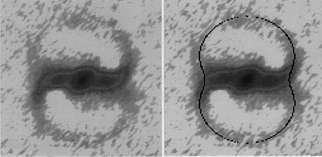
|
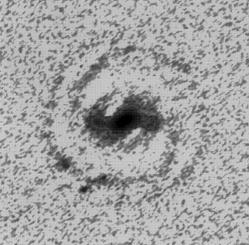
|
A substantial number of barred galaxies display a second type of
feature known as an R2' pseudoring (see lower left schematic
in Figure 16). In this type, the pseudoring is
defined by an
 270° winding of
the outer arms with respect to the
bar ends, so that in two opposing quadrants the arm pattern is
doubled. The pseudoring closes roughly along the line perpendicular to
the bar in the galaxy plane, and dimpling is not generally seen. When
deprojected, some of the best examples of this type of feature do not
necessarily close, as shown by ESO 294-16 in
Figure 19.
270° winding of
the outer arms with respect to the
bar ends, so that in two opposing quadrants the arm pattern is
doubled. The pseudoring closes roughly along the line perpendicular to
the bar in the galaxy plane, and dimpling is not generally seen. When
deprojected, some of the best examples of this type of feature do not
necessarily close, as shown by ESO 294-16 in
Figure 19.
Detached true outer rings do not readily fit into these subcategories because the classification depends on the character of spiral arms. However, some true rings have a dimpled shape similar to R1' rings and are referred to as R1-type rings. The outer ring of NGC 1326 (see Buta & Crocker 1991 and Figure 45) is an example.
Buta & Crocker (1991) also noted a possible correlation between the presence of an R1 or R1' outer ring/pseudoring morphology and the existence of nuclear star star formation. In an imaging survey of 29 early-type spirals, 9 out of 11 examples containing this type of outer feature included nuclear star formation in the form of blue nuclear rings, partial blue rings, or blue nuclei. In contrast, 8 out of 11 cases including a strong R2' outer feature showed no evidence for nuclear star formation.
The R1' and R2' morphologies were predicted by Schwarz (1981) as the kinds of patterns that would be expected near the OLR in a barred galaxy. Each pattern is linked mainly to one of two major families of periodic orbits expected near the OLR. Buta (1985, 1986a) identified a rare combined pattern (not predicted by Schwarz) referred to in Buta & Crocker (1991) as the R1R2' morphology, where the outer arms break not from the ends of the bar, but from an R1-type ring. The prototype of this morphology is ESO 509-98, which is illustrated schematically in Figure 16 and in reality in Figure 17 (see also Buta & Crocker 1991). An excellent large example is found in NGC 1079 (Buta 1995). The existence of this combined type, which may be linked to the population of both main families of OLR periodic orbits, provides some of the clearest evidence of the OLR in barred galaxy morphology. We discuss the theoretical aspects of these features in more detail in section 12.2.